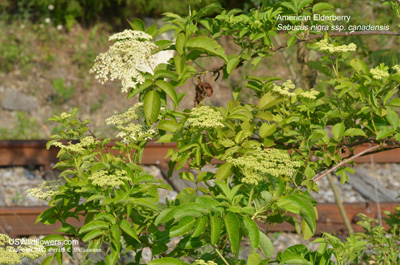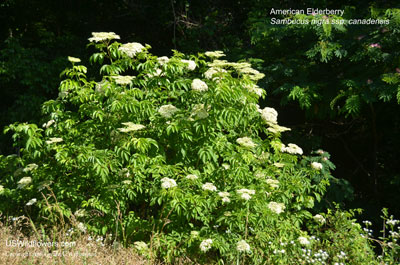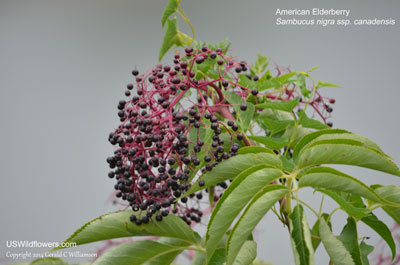Wildflowers of the United States | |||||||||||||
| |||||||||||||
Sambucus nigra ssp canadensis - Common Elderberry, American Elderberry, American Black Elderberry. This shrub grows up to 10 feet tall and has many stems, forming dense thickets. The leaves are pinnate, with usually 7, occasionally 5, and even more occasionally 9 lanceolate, serrated leaflets. The plant has large cymes of small white flowers which will produce dark purple to black berries which can be used in jams and to make wine. The flowers, dried, can be used to make a tea. The unripe berries, the stems, and the leaves may be poisonous. | This is the more widespread subspecies of the Black Elderberry, being found in all but 5 of the lower 48 states. It is also in Hawaii, but as an introduced species. It was formerly classified as the separate species Sambucus canadensis. Another subspecies, S. nigra ssp.cerulea (formerly S. caerulea) is known as the Blue Elderberry, and has bluish berries. Blue Elderberry is found in much of the western half of the United States Found in: AL, AR, AZ, CA, CO, CT, DC, DE, FL, GA, HI, IA, IL, IN, KS, KY, LA, MA, MD, ME, MI, MN, MO, MS, MT, NC, ND, NE, NH, NJ, NM, NY, OH, OK, PA, RI, SC, SD, TN, TX, VA, VT, WI, WV, WY Leave comments on Sambucus nigra ssp canadensis at this link.   Blue=Native; Grey=Introduced Map from USDA Plants Database: USDA, NRCS. 2017. The PLANTS Database (http://plants.usda.gov, 08 May 2025). National Plant Data Team, Greensboro, NC 27401-4901 USA. Search Our Database: Enter any portion of the Scientific, Common Name, or both. Do a general Google search of the entire site: #ad
|
| #ad
| | |||||||||
|
Commercial / Cookie Notice Looking for Wildflowers for a specific state? Check here: | |||||||||||||
|
| |||||||||||||




